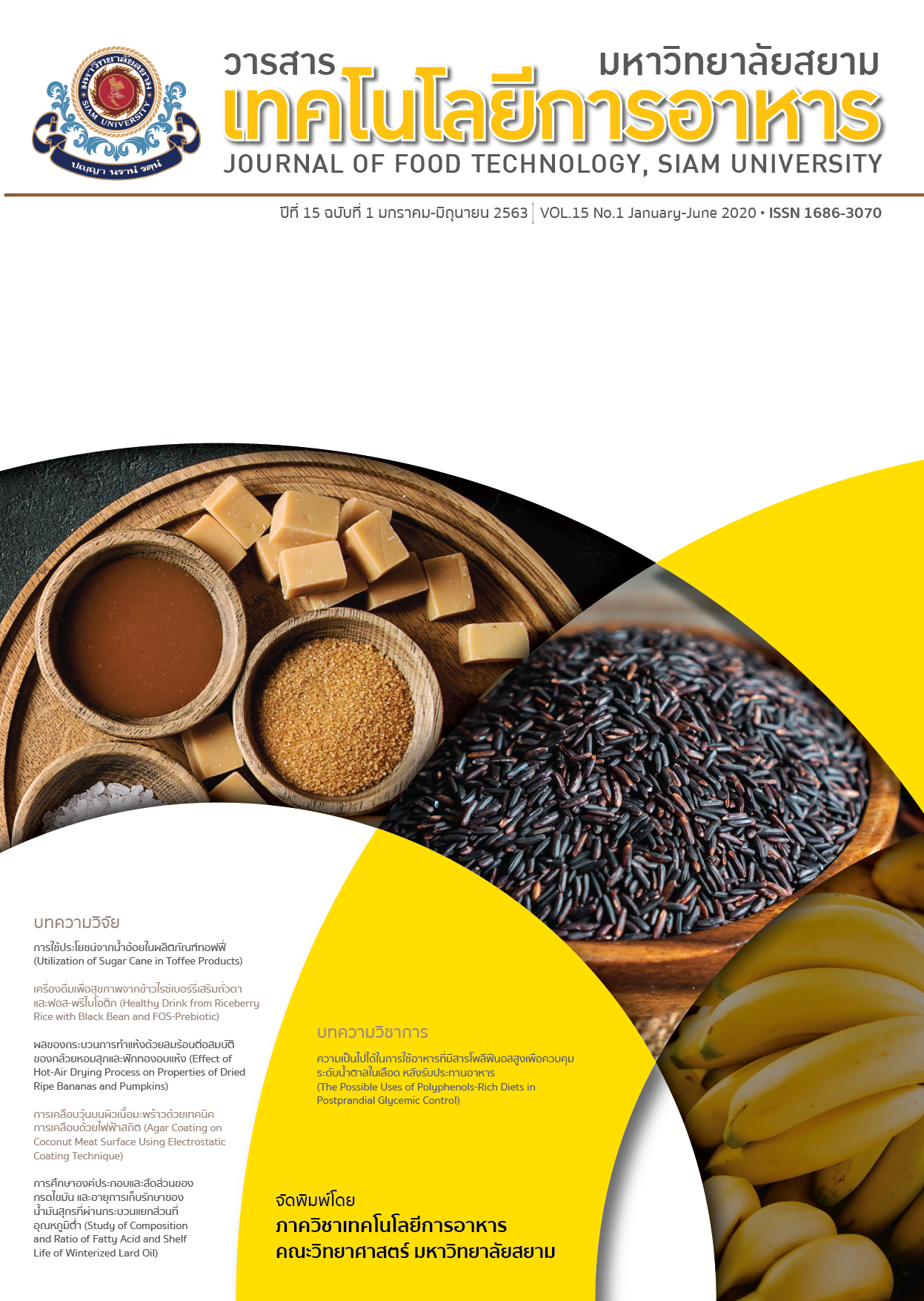Utilization of Sugar Cane in Toffee Products
Main Article Content
Abstract
This research aimed to optimize the formula to produce toffees. The seven formulas of toffees consisting of sugar cane (0-40%), granulated sugar (0-40%) and glucose syrup (0-60%) were studied by using Mixture Design. Physical properties and sensory evaluation by trained panelists were investigated. The results showed that glucose syrup contents had a significant role on viscosity, hardness, moisture content and color value of toffees. Obviously, an optimum formula of toffees was 40% sugar cane, 0% granulated sugar and 60% glucose syrup, respectively. This formula had the highest score of appearance (7.13+0.74), flavor (7.27+0.88), chewing (7.07+0.70), stickiness (7.00+0.85) texture (7.07+0.80), taste (7.20+1.08) and overall liking (7.13+0.92). Furthermore, effects of different temperatures on the quality of toffees were studied. The results indicated that the moisture content tends to decrease when the temperature increased. The hardness and viscosity of toffees varied directly with temperature, and brightness of toffee (L*) tended to decrease when the temperature increased. Interestingly, the optimum temperature for toffee production is 120๐C for 15 minutes. In addition, the development of varied flavor and taste of toffee by adding coffee, green tea, cocoa and lime powder were investigated. There was not a statistical significance in sensory evaluation. Since the sugar cane is the availability of a local raw material, it is suitable for toffee production and it will also increase value-added agricultural products as well as make a variety of food products as new choices for consumers.
Article Details
Copyrights of all articles in the Journal of Food Technology available in print or online are owned by Siam University and protected by law.
References
[2] Hhowthawee, S. (2003). Sugar technology. Kasetsart University Press. Bangkok.
[3] Maneechai, T. and Pinsirodom, P. (2013). Physicochemical composition, phenolic content and antioxidant properties of sugarcane juice and optimum condition for hydrolysis of sucrose in sugarcane juice by invertase. [Online] Available from http://www.lib.ku.ac.th/KUCONF/ 2556/KC5106008.pdf. [Accessed April, 10, 2017].
[4] Thai industrial standards institute. (2016). Community product standards: Toffee (256/2559). [Online] Available from https://www.tisi.go.th. [Accessed April, 10, 2017].
[5] Duncan, D.B. (1995) Multiple range and multiple F Tests. Biometrics. 11: 1 – 42.
[6] Kaewnoo, T and Phonrak, H. (2017). Sugar science. Journal Sugar. 1(1): 33-51.
[7] Thai industrial standards institute. (2004). Community product standards: Cane sugar (508/2547). [Online] Available from https://www.tisi.go.th. [Accessed April, 10, 2017].
[8] Pedcharat, K., Saetang, D., Tungsatitporn, D., and Sakulyunyongsuk, N. (2012) Development of candy from Thai herb: reduce inflammation. Research Report. Faculty of home economics technology. Rajamangala University of Technology Phra Nakhon. Bangkok.
[9] Songtip, P., Jangchud, K., and Wuttijumnong, P. (2007). Study of optimum ratio of sweeteners to produce snack bar from brown rice and herb. [Online] Available from http://www.lib.ku.ac.th/KUCONF/ KC4506042.pdf. [Accessed April, 10, 2017].
[10] Phunjabhud, N. and Hongrak, K. (2012) Study on mango varieties and optimum glucose syrup in mango toffee production. The 2nd National and International Graduate Study Conference. Silpakorn University.
[11] Sriroth, K. and Piyachomkwan, K. (2007). Starch Technology. Kasetsart University Press, Bangkok.
[12] Niyomrath, R. (2012). Energy saving stove for stew coconut sugar by local raw material in Bang Khon Thi District, Samut Songkhram province. Research Report. Suan Sunandha Rajabhat University. Bangkok.
[13] Thai industrial standards institute. (2009). Thai industrial standards institute: Sugar (56/2552). [Online] Available from https://www.tisi.go.th. [Accessed April, 10, 2017].
[14] Pornchaloempong, P. and Rattanapanone, N. Evaporation. [Online] Available from http://www.foodnetworksolution.com. [Accessed April, 10, 2017].
[15] Rattanapanone, N. (2014). Food chemistry. Bangkok Odeon store.
[16] Rungsadthong, V. (2014). Food processing technology. King Mongkut's University of Technology North. Text and Journal Publication Co.,Ltd. Bangkok.
[17] Charoenrein, S and Reepholkul, K. (2013). Glass transition of sugar during production of peanut brittle. Food. 43(3): 74-81.
[18] Ajandouz, E.H., Tchiakpe, L.S., Dalle Ore, F., Benajiba, A. and Puigserver, A. (2001). Effects of pH on caramelization and maillard reaction kinetics in fructose-lysine medel systems. JFS: Food Chemistry and Toxicology. 66(7): 926-931.
[19] Jhantakul, S., Hongrattanavorakit, S., Boonyarutkalin, T., Owajariyapitak, D., Phonphanpipat, S., Deejali, P., and Tapin, S. (2016). The development of incense sticks product from lime skin. Research Report. Faculty of home economics technology. Rajamangala University of Technology Phra Nakhon. Bangkok.
[20] Thepkhon, T. (2013). Green tea catechins and storage stability. KKU Science Journal. 41(1): 46-55.
[21] Bunteongjit, D. (2004). Green tea. Journal Department of Science Service Ministry of Science and Technology. 52(164): 10-14.
[22] Suphamityotin, P. (2013). Fruit and vegetable technology. Bangkok. Odeon store.
[23] Rungsrangtham, N. (2006) Changes volatile compounds in roasted arabica coffee beans during storage. Master’s thesis. Silpakorn University. Nakhon Pathom.
[24] Wongnai, W. (2016). Cocoa: the best food and magic medicine of all ages. Horticultural Science Society of Thailand. 32(1): 4-6.


